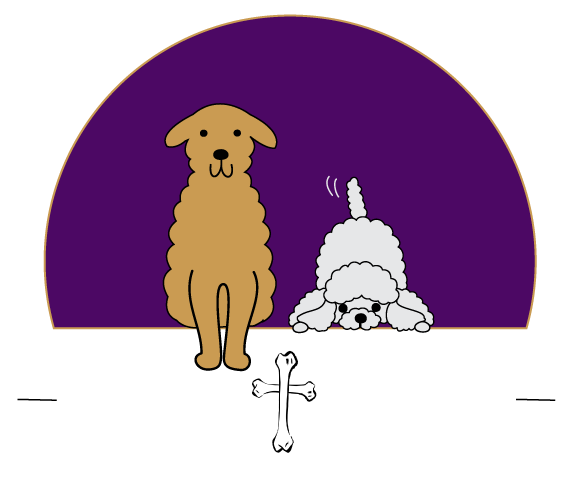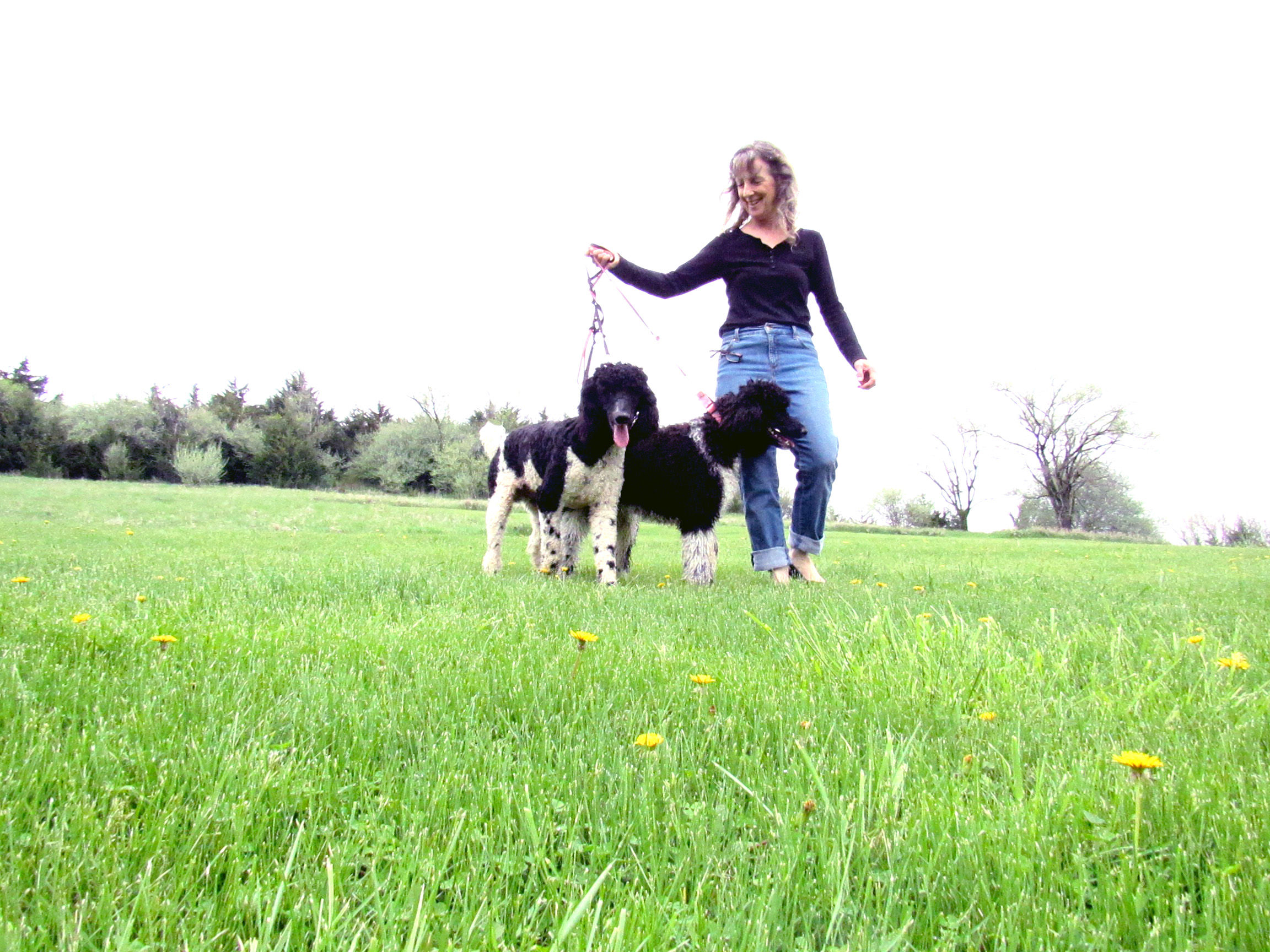It was July. We lost our puppy in May, and it still hurt. There was something about his sweet face and disposition that had drawn me in, and I was still hurting. In July I decided to start looking for a new puppy. This time I was just going to look. After my previous experience with a puppy, I decided it was okay if it took year or two to find another one, I was in no hurry this time. I was going to pray about the right puppy and wait for God’s timing, however long that would take. And this time, I was not going to accept a puppy that had either vaccines or was given harsh chemical dewormers.
I spent hours on the internet late in the evenings. Then a friend called to tell me she had learned of a family in South Dakota that had Standard poodle puppies for sale. I called the family and talked to the man who was selling the pupppies, and was willing to let me come see their dogs and their whole farm. They had two puppies left from the last litter, unfortunately though, they were both vaccinated and dewormed. They were, however, willing to set aside a puppy from the next litter and not vaccinate it or give it dangerous deworming chemicals. This was good, I thought. I went ahead and made an arrangement to go see their place and interview them.
Two weeks later I was on my way to South Dakota to meet these new breeders of standard poodles. I found my way to their farm and got the tour. Then we sat outside in the shade under the trees and visited while the puppies played in the yard with their mother. They seemed willing to talk about why I wanted a dog without vaccines, so I shared with them a little of what I knew, and my experience with having lost a puppy. As is typical, they were concerned that a puppy without vaccines would get sick, because this is what they had been told. They were also unaware of how dangerous the chemical dewormers were on a puppy’s gut and kidneys. I encouraged them to research the topic and suggested they tell their vet to do the same. Their vet, like so many other vets, hadn’t provided any proof the vaccines or the dewormer were either safe or effective. Instead, when he was questioned about their safety, told them the same thing we so often hear from medical doctors that have no proof something is effective. That “anyone can find studies to support whatever they want to believe if they look hard enough.” I think it’s interesting that that doesn’t apply to them! I encouraged this couple to challenge their vet with providing them his proof first. He was the one pushing the vaccines, and had everything to gain from the sale, shouldn’t he provide written proof of the safety and efficacy of the vaccines?
A few weeks later, I was sharing what I knew about canine vaccines with a friend who had recently acquired 3 dogs from a shelter. These poor dogs had been pumped full of every vaccine available to dogs. I find this is typical of these shelters. They call it “humane,” but I would argue that, in regard to their vaccine policies and practices. There is nothing humane about pumping anyone, or anything, full of poisons. My friend knew she had a long road ahead of her trying to restore the health of these dogs after their stay in the shelter. The first thing she did was to find a holistic veterinarian who would have an intelligent discussion with her on the topic of vaccines. One who had researched them herself, instead of just reiterating what she had been taught to believe in veterinary school.
The veterinarian she found, told my friend that she too was not in favor of the vaccines done on animals. Not even the rabies vaccine. Most of us gasp at the thought that our dog doesn’t need a rabies vaccine. Afterall, look what happened on the movie Old Yeller. And, as I heard one woman exclaim, “rabies is so dangerous, if you get bit by a dog that hasn’t had a vaccine for it, you have to get a series of very painful rabies shots in your abdomen to prevent you from getting it.” Do you really? I personally know two people who didn’t, even though they were told that lab tests indicated that the dogs that bit them had rabies. They are fine.
Another person got bit by a bat on his middle toe while playing soccer barefoot in the woods with some friends. Yes, bats are known to eat bugs off the ground at night in the woods. He actually had to pry the bat off of his foot. After approximately 24 hours, and several more games of soccer, his foot had swollen up to the point that it hurt to step down on it, so he went home. He was a teenager, which explains the lunacy of this story! His mother, who used naturopathic medicine rather than allopathic, had him wash his feet good, then gave him 3 doses of a rabies homeopathic to address the possibility of rabies from the bat. She witnessed a marked reduction in the swelling in his foot within just 30 minutes, at which time her son went back out with his friends. That was eight years ago. She said she knew rabies doesn’t go to the brain in people, or animals, like the vaccine does, so she wasn’t concerned. But did warn her son that if any other symptoms should occur, he was to return home immediately.
My question is: Is the real rabies a natural, opportunistic virus for dogs, just like parvo and distemper are? In other words, do dogs get it naturally when they eat wild animals, rodents, road-kill, but don’t show symptoms because its not really the problem its blamed on being?
Lets side-step rabies for a moment and look at a couple of other viruses. The parvo and distemper viruses. Research indicates there is a vaccine component (i.e., a modified/resistant strain) to those animals who exhibit symptoms from these viruses. In fact, dogs who get the parvo and distemper vaccines together, sometimes soon after, exhibit the very symptoms blamed on rabies: Moodiness, personality changes, sudden episodes of violence and rage. Maybe this is just a coincidence, you say, because the dog is sick from being vaccinated. This is true, just as children are sick after vaccines, and understandably so, since they were injected with several disease cells all at once (this never happens in nature), along with a number of chemicals, additives, parasites from the diseased animal and/or aborted fetal cells, all in the same vaccine. We, and/or our pets certainly should be sick. No wonder so many die or suffer chronic illness, auto – immune disease, and permanent damage afterwards.
However, that aside, I have spoken to a number of people who did the Parvo-Distemper vaccine homeopathic when their animals exhibited symptoms of rage, anger, moodiness, and snapping (in the attempt to bite) to address vaccine brain damage. Then soon after the homeopathic was given, the personality of their animals changed back to the sweet animal they were familiar with.
One person said she gave this remedy to both their golden retriever and their son. She said both of whom were sweet, loving beings until their dog had this vaccine. After trying the homeopathic on both of them they not only had a very welcome personality shift back to the normal, but her son excelled in school once again. What was amazing was that in this particular situation the Parvo-Distemper vx homeopathic wasn’t given until 2 years after the vaccine had been given. This same combination homeopathic, I’ve been told, works wonders on dogs who seem to “hate children.” What do I mean by that? These are dogs who will snap at children, lunge at children, growl at children, or otherwise have no tolerance for children. If you decide to try this remedy on your pet(s) remember, its the remedy made from the vaccines, not the normal viruses. The normal viruses do not appear to cause these symptoms.
Lets get back to rabies. If what you know about rabies is limited to what you saw in the movie, or have heard in the media…you know the picture, the insane animal frothing at the mouth, attacking every moving thing in sight. You may have been misled. After the release of the Old Yeller movie, the public’s impression of rabies was that it could cause insanity, biting, foaming at the mouth, infection and eventual death in those who came in contact with it. I have not been able to personally find any studies to substantiate these beliefs. My friend with the shelter dogs that I mentioned above, asked her veterinarian about rabies, and was surprised when she told her that she has never seen any proof that rabies causes any of the symptoms we have been led to believe it does. She went even further to tell her that she didn’t know anyone in veterinary medicine who had seen a case of rabies that did anything obvious to the animal. Not even while in veterinary school. Another veterinarian of 28 years, when asked about this same vaccine, commented “I don’t care whether you vaccinate with rabies or not, it doesn’t do anything that benefits the animal anyway.”
Doctor Martin Goldstein, D.V.M., in his book, The nature of Animal Healing had an interesting take on rabies. Although he does believe that rabies can cause a dog to have violent mood shifts and violent tendencies, has this to say about the vaccine:
“Administered annually by law in many states, and by vererinarians’ recommendaion in most others,
the rabies vaccine bombards a pet’s immune system with alarming amounts of foreign substances.
In cats, the vaccine has been linked to fibrosarcomas. In both cats and dogs, it contributes to chronic
vaccinosis (illness caused by vaccines), as well as the rabies miasm (illnesses passed down through the generations ). If you live in a state that does require annual rabies vaccination by law, all you can
do is protest – or move. If you don’t, let moderation, not the fearful images of rabid dogs from the movies,
be your guide… In my twenty-five years of veterinary practive, I haven’t observed or treated a single
case of it. Does the vaccine get all the credit? I think not. .. As for the rare case of a rabid bat, say,
biting a person and infecting her with rabies, it’s true, those cases occur. Do we all submit to annual
rabies vaccine as a result? Of course not! So why should our pets?”
Why do medical authorities still act as though there is undeniable proof rabies is so dangerous to dogs, and therefore humans? One possible explanation might be what Doctor Robert Bradley, M.D., called blind acceptance. Once the idea is put out there, in this case by a movie, and the general public believes it, they apply pressure on medical authorities to provide a solution. And the medical authorities are happy to oblige, because there isn’t any reason not to. Whether or not the solution is viable, or backed by studies, is neither here nor there, as long as it appeases the masses and makes the medical society a great deal of money.








